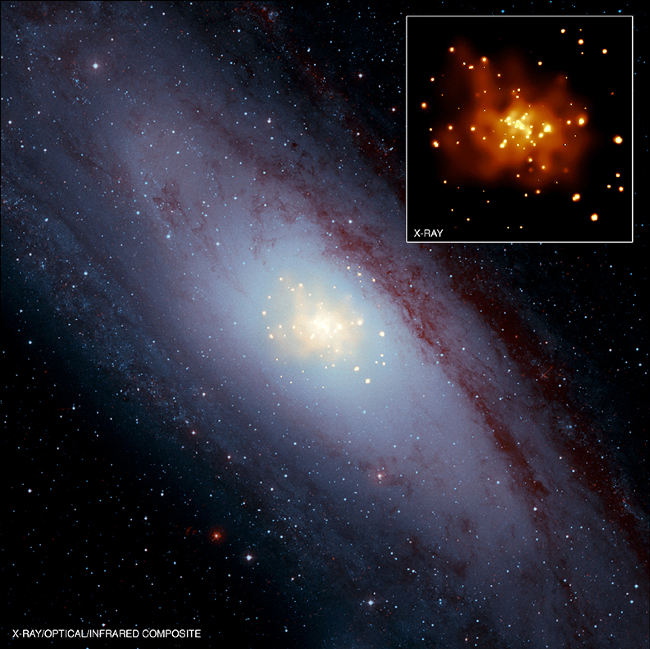
 Credit: X-ray (NASA/CXC/MPA/M.Gilfanov & A.Bogdan), Infrared (NASA/JPL-Caltech/SSC), Optical (DSS)
Credit: X-ray (NASA/CXC/MPA/M.Gilfanov & A.Bogdan), Infrared (NASA/JPL-Caltech/SSC), Optical (DSS)
A Test of Type Ia
Type Ia supernovae are powerful explosions, emitting as much light as a small galaxy at their peak. Type Ia supernovae are believed to mark the death of a white dwarf that's been pushed over the Chandrasekhar Limit just a bit too much. The Chandrasekhar Limit is the limiting mass, about 1.4 solar masses, which can be supported by degenerate electron pressure, and was first described by Subrahmanyan Chandrasehkar, the Nobel Prize winning physicist. But what pushes the white dwarf over the limit? The favorite model has been that the white dwarf accretes material from a companion star, slowly increasing in mass until the white dwarf is just above 1.4 solar masses. At that point catastrophic thermonuclear fusion of carbon begins, blasting the star apart. If all type Ia supernovae explode by thermonuclear fusion of 1.4 solar masses of carbon, then they should be excellent standard candles, allowing astronomers to calculate distant distances by comparing their observed and intrinsic luminosities. But a new study with the Chandrasekhar's other namesake, the Chandra X-ray Observatory, has now cast doubt on this picture. This study measured the overall X-ray luminosity of a number of galaxies (like M31, the Andromeda Galaxy, shown above) and compared the observed luminosity to that expected from the population of accreting white dwarfs necessary to explain the overall rate of type Ia supernovae. The Chandra observations indicated that the X-ray luminosities of these test galaxies was a factor of about 50 less than it would be if there were enough accreting white dwarfs to produce the expected type Ia supernovae rate. The question then becomes, if accreting white dwarfs don't produce type Ia supernovae, what does? One suggestion: merging white dwarf binaries.
Published: February 22, 2010
<
HEA Dictionary ● Archive
● Search HEAPOW
● Other Languages
● HEAPOW on Facebook
● Download all Images
● Education ● HEAD
>

Each week the HEASARC
brings you new, exciting and beautiful images from X-ray and Gamma ray
astronomy. Check back each week and be sure to check out the HEAPOW archive!
Page Author: Dr. Michael F. Corcoran
Last modified Monday, 26-Feb-2024 17:23:58 EST


